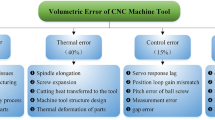Abstract
An algorithm for three-axis NC tool path generation on sculptured surfaces is introduced when the free-form surface is modeled parametrically by free-form surface Kriging. The flexibility of dual Kriging that easily defines the intersection of the surfaces with a set of parallel planes and Cartesian method are combined to generate the tool-paths automatically. The presented algorithm can simultaneously generate the tool path with a predefined machining accuracy and remove gougings along the tool path. The algorithms are validated by three experiments in rough and finish machining and the results prove its reliability. Since Kriging is based on the interpolation of data points, the proposed algorithm can be used for reverse engineering applications. The system was executed on a standard micro-computer and the software was structured to offer a library of machining functions for endusers.
Similar content being viewed by others
References
Faux, I. D. and Patt, M. J., “Computational Geometry for Design and Manufacturing,” Ellis Horwood Publisher, 1979.
Kim, H. C. and Yang, M. Y., “An Optimum 2.5D Contour Parallel Tool Path,” Int. J. Precis. Eng. Manuf., Vol. 8, No. 1, pp. 16–20, 2007.
Loney, G. C. and Ozsoy, T. M., “NC Machining of Free Form Surfaces,” Computer-Aided Design, Vol. 19, No. 2, pp. 85–90, 1987.
Yoon, J. H., “Fast tool path generation by the iso-scallop height method for ball-end milling of sculptured surfaces,” Int. J. Prod. Res., Vol. 43, No. 23, pp. 4989–4998, 2005.
Yoon, J. H., “Two-dimensional representation of machining geometry and tool path generation for ball-end milling of sculptured surfaces,” Int. J. Prod. Res., Vol. 45, No. 14, pp. 3151–3164, 2007.
Ding, S., Mannan, M. A., Poo, A. N., Yang, D. C. H. and Han, Z., “Adaptive iso-planar tool path generation for machining of free-form surfaces,” Computer-Aided Design, Vol. 35, No. 2, pp. 141–153, 2003.
Huang, Y. and Oliver, J. H., “Non-constant Parameter NC Tool Path Generation on Sculptured Surfaces,” Computers in Engineering, Vol. 1, pp. 411–419, 1992.
Lee, C.-S., “Geometric equation and machining method for the sidewall of a piston,” Int. J. Precis. Eng. Manuf., Vol. 10, No. 1, pp. 3–6, 2009.
Bobrow, J. E., “NC Machining Tool Path Generation from CSG Part Representations,” Computer-Aided Design, Vol. 17, No. 2, pp. 69–76, 1985.
Krige, D. G., “A Statistical Approach to Some Basic Mine Valuation Problems on the Witwatersrand,” Journal of the Chemical, Metallurgical and Mining Society of South Africa, Vol. 52, No. 6, pp. 119–139, 1951.
Vafaeesefat, A. and ElMaraghy, H. A., “Smooth Sculptured Surface Fitting Using Dual Kriging for Reverse Engineering,” CIRP-Journal of Manufacturing Systems, Vol. 29, No. 1, pp. 33–37, 1999.
Mohan, S., Kweon, S.-H., Lee, D.-M. and Yang, S.-H., “Parametric NURBS Curve Interpolators: A Review,” Int. J. Precis. Eng. Manuf., Vol. 9, No. 2, pp. 84–92, 2008.
Trochu, F., “Presentation of a Contouring Program Based on Dual Kriging Interpolation,” Engineering with computers, Vol. 9, pp. 160–177, 1993.
Author information
Authors and Affiliations
Corresponding author
Rights and permissions
About this article
Cite this article
Vafaeesefat, A. NC machining of free-form Kriging surfaces. Int. J. Precis. Eng. Manuf. 11, 327–333 (2010). https://doi.org/10.1007/s12541-010-0038-8
Received:
Accepted:
Published:
Issue Date:
DOI: https://doi.org/10.1007/s12541-010-0038-8




